|
Richard G. Hills, David C. Maniaci, Jonathan W. Naughton. "V&V Framework". September 2015.
Wind Energy
Large-Eddy Simulation of SWiFT Turbine Array
The
total energy produced by a wind farm depends on the complex interaction of many
wind turbines operating in proximity with the turbulent atmosphere. Sometimes
the unsteady forces associated with wind negatively influence power production,
causing damage, and increasing the cost of producing energy associated with
wind power. Wakes and the motion of air generated by rotating blades need to be
better understood. Predicting wakes and other wind forces could lead to more
effective wind turbine designs and farm layouts, thereby reducing the cost of
energy, allowing the United States to increase the installed capacity of wind
energy.
The Wind Energy Technologies Department at Sandia has collaborated
with the University of Minnesota to simulate the interaction of multiple wind
turbines. By combining the validated, large-eddy simulation code VWiS with
Sandia’s HPC capability; this consortium has improved its ability to predict
unsteady forces and the electrical power generated by an array of wind
turbines. These quantities were found specifically for the Sandia Scaled Wind
Farm Technology (SWiFT) facility, aiding the design of new wind turbine blades
being manufactured as part of the National Rotor Testbed project for the
Department of Energy.
Three specific areas of research were addressed with different
simulation cases. First, researchers investigated the persistence of the wake
for unique distributions of force along the wind turbine blades. Unique force
distributions produced unique wake contours; however turbulence removed any
differences beyond 4 rotor diameters downstream. The next simulation
investigated the effect of scale on wake persistence and showed that two wind
turbines of the same design but different scales will produce different wakes.
Finally, the simulations of the experimental SWiFT facility quantified the potential
for increased power and force fluctuations of downwind turbines. The research findings have already influenced
the aerodynamic design of new wind turbine blades being considered at Sandia.
This research was presented at NAWEA 2015 Symposium.
Xiaolei
Yang, Daniel Foti, Christopher L. Kelley, Fotis Sotiropoulos , “Large-Eddy Simulation of SWiFT Turbines Under Different
Wind Directions,” North American Wind Energy Academy 2015 Symposium,
June 9—11, 2015, Blacksburg, VA.
Chris
Kelley, (505) 845-9036.
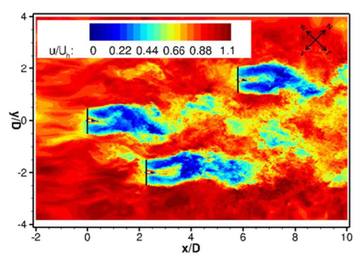
Figure 1.
Velocity contour of a southwest wind for the three SWiFT wind turbines.
MOU Agreement with the Technical University of Denmark (DTU) Extended until
2020 for Continued Cooperation in Wind Energy Technology Development
Recently,
Sandia and the Technical University of Denmark (DTU) signed a new MOU
(Memorandum of Understanding) agreement to continue cooperation on wind energy
technologies research and development.
The agreement involves Wind and Water Power technologies programs at
Sandia and the Wind Energy Division and Composites & Materials Mechanics
Programme in the Materials Research Division, both at the Technical University
of Denmark. The original MOU was
executed in 2010 for a period of 5 years.
The current extension, which highlights continued interests and
opportunities for cooperation, will be in effect until 2020. The new agreement was signed by Peter Hauge
Madsen, Head of Department at DTU Wind Energy, and by David Corbett, Acting
Vice President of Sandia Division 6000.
The
MOU agreement calls for general areas of collaboration including but not
limited to:
-
Collaborations between Sandia and DTU staff
and students,
-
Involvement of DTU students in Sandia
projects,
-
Projects requiring sharing of complementary
capabilities,
-
Pursuit of joint funding opportunities,
-
Involvement of Sandia staff in directing
graduate students,
- Opportunities for collaborative use of
specialized research equipment,
- Pursuit of joint ventures, and
-
Coordination of education and research in
areas of common, strategic interest to both organizations.
Sandia
and DTU Wind have made meaningful steps over recent years in cooperative and
collaborative activities including organization of a joint workshop on Offshore
Vertical Axis Wind Turbines (VAWTs) in 2014, DTU participation in Sandia Blade
Workshops (2012, 2014), and technical exchanges on a variety of topics of
common interest including offshore wind and rotor technology development. In addition, in coming months, Sandia will
travel to Denmark to participate on a PhD committee for a DTU Wind student
working on offshore VAWTs (November 2015).
This trip will include discussions regarding current priorities and new
opportunities for collaboration between DTU and Sandia under the framework of
the MOU agreement.
D.
Todd Griffith, (505) 845-2056.
Water Power
WEC-Sim Leveraged to Model Floating Offshore Wind Experiments
The
University of Minnesota and Sandia National Laboratories have partnered
together over the past three years for the DOE funded offshore wind FOA on the
high resolution modeling of offshore wind turbines and farms. In 2013, the
University of Minnesota performed experimental tests on a floating offshore
wind turbine in the Saint Anthony Falls Laboratory wave flume. The 1:100 scale
floating offshore wind turbine experimental design was based on the Sandia
National Laboratories 13.2 MW wind turbine mounted on a cylindrical barge
platform. The floating offshore wind
platform experimental setup is shown in Figure 2, where the platform is
restricted to heave and pitch motion only since these are the primary modes of
motion.
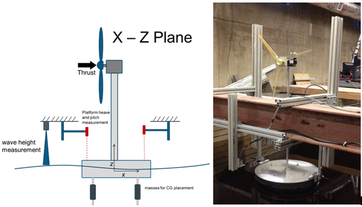
Figure 2.
Floating offshore wind platform experimental test setup, restricted to heave
and pitch motion only.
The motivation behind the experimental testing was to provide a data set for validation of the University of Minnesota's high resolution VWIS code. In support of this project, Sandia National Laboratories provided Boundary Element Method (BEM) results for comparison to the VWIS code, and recently Sandia National Laboratories leveraged the open source WEC-Sim code (developed to simulate Wave Energy Converters in operation waves) to model the floating offshore wind experiments.The WEC-Sim code was used to model the hydrodynamic response of the floating platform, as well as the heave and pitch constraints. Results of these simulations are shown in Figures 3 and 4 and match the experimental data well. Since the BEM solution is a low order model, WEC-Sim is a mid-fidelity code, and VWIS is a high resolution code, these results will demonstrate the comparative accuracy of different fidelity numerical codes in comparison to the experimental data.
Kelley Ruehl, (505) 284-8724.

Figure 3. WEC-Sim
Simulation of Offshore Wind Turbine Experiments.
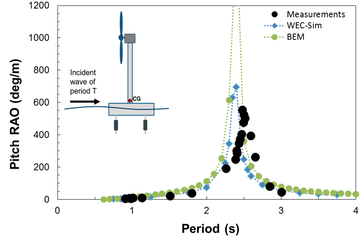 Figure
4. Comparison of WEC-Sim Simulations to
Experimental Data and BEM Solution.
PTO-Sim: A Power Performance Module for WEC-Sim
Ratanak So, a PhD student in Electrical and Computer
Engineering advised by Dr. Ted Brekken at Oregon State University, worked at
Sandia National Laboratories as a Summer 2015 intern. Over the past year, he
has been developing PTO-Sim (Power Take-off Simulator), the WEC-Sim module
responsible for accurately modeling a WEC’s conversion of mechanical power to
electrical power. While the PTO used in the WEC-Sim example is modeled as a
simple linear damper, PTO-Sim is capable of modeling many power conversion
chains (PCC) such as mechanical drivetrain and hydraulic drivetrain. Therefore,
the user can quickly see the effects of different PTO configurations. PTO-Sim
is made of native Simulink blocks coupled with WEC-Sim using WEC-Sim’s
user-defined PTO blocks, where the WEC-Sim response (relative displacement and
velocity for linear motion and angular position
and velocity for rotary motion) is the PTO-Sim input. Similarly, the PTO force
or torque is the WEC-Sim input.
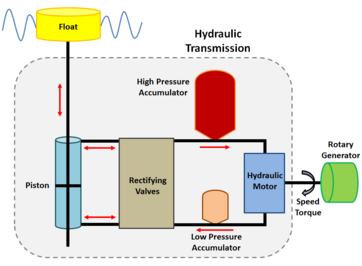 Figure 5. Schematic
of the PTO-Sim hydraulic model.
On August 21, 2015, PTO-Sim, as part of WEC-Sim,
was released as an open source code and is available at https://github.com/WEC-Sim/WEC-Sim. PTO-Sim was developed to support WEC-Sim, but it is also compatible
with other WEC code that is capable of simulating WECs of arbitrary device
geometry subject to operational waves. A wide range of PTO components are
currently available but more components are being built and will be added in
the near future.
The PTO-Sim project is funded by the U.S.
Department of Energy’s Wind and Water Power Technologies Office.
Ratanak So & Kelley Ruehl, (505) 284-8724.
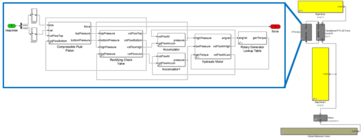 Figure 6. Simulink model of the hydraulic system and WEC-Sim RM3 model with PTO-Sim.
|